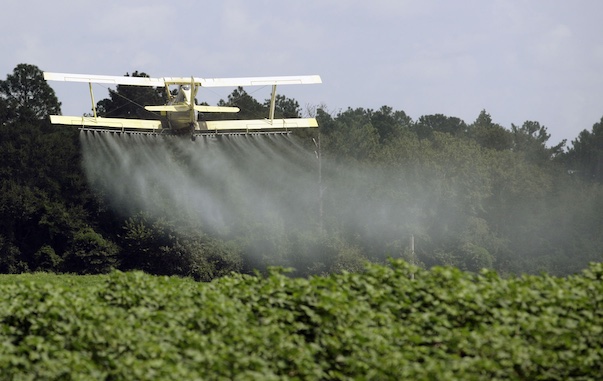forum
library
tutorial
contact

Oregon to Phase Out Most Uses
of Chlorpyrifos by End of 2023
by George PlavenCapital Press, December 16, 2020
|
the film forum library tutorial contact |

|
Oregon to Phase Out Most Uses
by George Plaven |
 SALEM -- Oregon is moving forward with a final rule to phase out most uses of the pesticide chlorpyrifos by the end of 2023.
SALEM -- Oregon is moving forward with a final rule to phase out most uses of the pesticide chlorpyrifos by the end of 2023.
Chlorpyrifos was approved for use on more than 50 crops statewide -- including Christmas trees, hazelnuts, grass seed, alfalfa, sugar beets and cranberries -- but garnered controversy after studies showed it may have harmful neurological effects, especially in children.
The Oregon Department of Agriculture convened a 13-member workgroup in December 2019 to evaluate potential health and safety restrictions for chlorpyrifos. Members represented industry and environmental groups, farmworker advocates and public health experts.
Legislation to ban chlorpyrifos also passed the Oregon House earlier this year, before stalling in the Senate amid the Republican walkout.
Ultimately, ODA crafted a three-year phaseout that immediately classifies chlorpyrifos as a restricted-use pesticide. The rule, formally adopted Dec. 15, stops short of a complete ban and will continue to allow certain uses, such as cattle ear tags, pre-plant seed treatments and granular formulations aimed at controlling soil-borne pests.
"We feel like we came up with a rule that gives some flexibility to the agricultural community, and is protective of workers, bystanders and water quality," said Rose Kachadoorian, ODA pesticides program manager. "We will work with the industries as best we can to help find alternatives."
As of Jan. 1, 2021, chlorpyrifos may no longer be used to spray for mosquitoes, on golf courses or inside greenhouses unless they meet minimum ventilation standards.
Aerial spraying of chlorpyrifos is prohibited on all crops, except for Christmas trees within a short window from April 1 through June 15. Farmworkers cannot re-enter fields for at least four days after the last application.
Also beginning in 2021, only licensed applicators may use and handle chlorpyrifos. In the past, unlicensed employees could spray if they were supervised by someone who is licensed.
Buffer zones have been increased around sensitive sites and bodies of water. For aerial applications or non-targeted air-blast sprayers, the buffer is 300 feet. For targeted air-blast sprayers, the buffer is 150 feet, and for other ground-based equipment, it is 60 feet.
Sensitive sites include farmworker housing units, though not farm residences or non-residential agricultural buildings such as barns and livestock facilities. That is based on feedback from farm groups, Kachadoorian said.
"There was some concern that they have control over their own properties, and that to actually put a buffer there would take away a lot of land when they could just basically leave," she said. "So we allowed that particular option."
Farm residences are already covered by protections in the federal Application Exclusion Zone, part of the U.S. Agricultural Worker Protection Standard.
Mixing and loading chlorpyrifos can only be done by licensed applicators or by those who successfully complete an ODA-approved training course after March 1, 2021. Farms will be required to keep and maintain records for three years after each application.
Finally, after Dec. 31, 2023, it will become illegal to use or sell chlorpyrifos in the state except for cattle ear tags, seed treatment and granular formulations.
"We believe that with our (protective) measures, the phaseout of December 2023 is appropriate," Kachadoorian said.
Jenny Dresler, a lobbyist for the Oregon Farm Bureau and Oregonians for Food and Shelter, said the groups are still reviewing the final rule, though it does not appear to identify proposed alternatives or provide public funding for research.
"These are very significant restrictions," Dresler said. "We are going to be looking for an investment so growers aren't left without any tools down the road."
Kachadoorian said it is unlikely the state will dedicate any assistance from the general fund, especially when the legislature is dealing with the coronavirus pandemic and 2020 fire season.
However, Oregon State University did receive a $162,794 specialty crop block grant from ODA earlier this year to study alternatives to chlorpyrifos.
"We really intend to be meeting with other industries and find out what we can do to help them be able to grow their crops effectively," Kachadoorian said.
Related Pages:
Chlorpyrifos Ban Proposed in Washington Legislature by Don Jenkins, Capital Press, 1/30/20
Court Takes Chlorpyrifos Chemical Away from Farmers by Don Jenkins, Capital Press, 8/20/18
Related Sites:
The Facts on Chlorpyrifos by FactCheck.org
learn more on topics covered in the film
see the video
read the script
learn the songs
discussion forum
